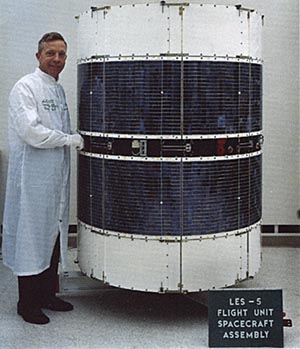Publications
Lab Notes
| LOOKING BACK | Published in the Lincoln Laboratory Journal, vol. 17, no. 1, November 2007 |
|
Saving a Satellite Most of Lincoln Laboratory was already on holiday when the July 4 weekend began in 1967. Not so at Lexington and at Cape Canaveral, where the teams that had designed, built, and tested Lincoln Experimental Satellite 5 (LES-5) and its associated communication terminals awaited the moment of truth [1]. Their efforts had been centered on extending the benefits of the new UHF technology, with its smaller and less expensive terminals, to military ships, aircraft, and land vehicles. I had just come back from Florida, where I told the press that LES-5 would be historic. The launch on Saturday, July 1, went smoothly. Telemetry indicated that most satellite subsystems were working properly. But there was a problem. The data revealed an on-board timing problem that would prevent the satellite from accepting telecommands. We were acutely aware of the urgency in fixing this. Prelaunch testing had shown that RF interference arose when the satellite’s telemetry and communication transmitters operated simultaneously. To avoid this interference, we launched LES-5 with its telemetry transmitter ON and its UHF transmitter OFF. Upon the satellite’s insertion into final orbit, the comm transmitter was to be turned ON and the telemetry transmitter turned OFF. But if LES-5 could not accept telecommands, it was for all practical purposes dead—a useless hunk of orbiting metal. The operators in Room B-224 (which is still used today for satellite monitoring and control) commenced sending test telecommands to verify link integrity. Nothing worked. We tried repeatedly to get LES-5 to accept telecommands. We didn’t know what else to do; LES-5 had only a few remote control knobs to turn.
Suddenly, after seven agonizing hours, the satellite acknowledged a test telecommand. Operators immediately sent a signal to turn ON the UHF transmitter. A fraction of a second later, the spectrum analyzer monitoring the downlink showed that the transponder was working. The telemetry transmitter was turned OFF, and in-orbit testing began. What had happened? Investigation of the problem disclosed that during predictable intervals each day as LES-5 moved along its orbit, signals from the satellite’s sun sensors blocked proper telecommand processing. Unbeknownst to us on launch day, the satellite had entered orbit during one of those periods, which lasted about 17 hours every day. When LES-5 moved into a more favorable position, the interference disappeared for the next five hours. The cycle repeated daily. As a result of the LES-5 experience, the prelaunch testing of LES-6—and all future Lincoln Laboratory–built spaceflight hardware—was much more thorough. LES-5 was a precursor to several major military communication satellite systems. The day before the 1967 launch there were no armed service requirements for mobile satellite communications; six months later, the Navy couldn’t get enough of UHF satcom. Indeed, LES-5 led directly to the Navy’s Fleet Satellite Communications System and the Air Force Satellite Communication System, both operating in the UHF. By extending military command and control down to new levels, this satellite has changed the way wars are fought, the way aggression is deterred, and the way peace is kept. —WILLIAM W. WARD REFERENCE |
||
